Guide to tuning the D16 engine from Honda
"Thanks for reading our Honda D16 Tuning tips"
Tuning the Honda D16 and best D16 performance parts.
A good solid engine used in quite a few Civic and Integra models over the years, it makes a good project basis to work from.
With lower compression adding forced induction makes a big difference.
Sadly most other bolt on mods fail to make that much difference but it is still possible to increase power by another 20% or so, relatively cheaply.
We provide a guide to D16 tuning and report on the ultimate upgrades. Honda D16's have loads of potential and with a few sensible parts you can greatly increase your driving opportunities.
We rely on our visitors to pass on tips and tell us about their projects and what worked on their car, and this article is the culmination of the feedback we have received. First let us look at the history and specs of this engine and then consider which tuning modifications work best on it.
History of the D16 Engine
- 86–89 1.6 L D16A1 (Integra) DOHC
- 86–89 1.6 L D16A3 (Integra) DOHC (Australia)
- 88–91 1.6 L D16A6 (Civic) Si, (CRX) Si, (Civic) EX (South Africa)
- 88–89 1.6 L D16A8 (Integra) DOHC
- 88–89 1.6 L D16A9 (Integra) (CRX in Europe) DOHC (South Africa)
- 92–95 1.6 L D16Y1 (Civic) Vti SOHC (Australia)
- 96–00 1.6 L D16Y4 (Civic) İES NON VTEC(TURKEY)
- 96–00 1.6 L D16Y5 (Civic) HX VTEC-E
- 97–00 1.6 L D16Y7 (Civic) DX/LX/CX
- 96–00 1.6 L D16Y8 (Civic) EX/(Canada)Si VTEC
- 90–92 1.6 L D16Z5 (Civic) (CRX in Europe) DOHC
- 92–95 1.6 L D16Z6 (Civic) EX/Si, Del Sol Si VTEC
- 98–06 1.6 L D16A (HR-V) J/J4
- 98–06 1.6 L D16A (HR-V) JS/JS4 VTEC
- 96–00 1.6 L D16Y8 (Civic) EX/(Canada)Si VTEC
What are the most effective D16 parts
Just because a upgrades is popular with D16 owners it doesn't mean you should fit it, instead we will best upgrades that will give your D16 the biggest power gain return for your cash.
Significant gains can be made from cam upgrades. Altering the cam profile alters the intake and exhaust durations on the engine and can dramatically change the power band and power output.
Fast road cams commonly boost the power through the rpm band, you could drop a little bottom end bhp but the high end rpm power will be lifted.
Competition cams, boost the high end rpm power band but as a result the car will not idle smoothly and low end power nearly always suffers.
If you have VTEC it is possible to get the VTEC to cut in at lower RPM ranges effectively giving you the sportier cam profile across more of the engines power band.
For a car driven daily you need to optimize your engines power to your driving style.
I'd be amazed if you have found a Motorsport and race camshaft is a pleasure to live with when on the daily commute.
Each engine responds better to more aggressive cam durations than others.
The engine timing and fuel pump and injectors also have a large bearing on the power gains you'll get.
Extending exhaust or intake durations can alter the power band and on most engines the exhaust and intake durations do not need to match, although most cams and tuners use matched pairs there are some advantages to extending the intake or exhaust durations.
Please watch our introduction Video tutorial to car tuning. Be sure to subscribe and support our new channel.
How to tune your car
- Improve the handling
Focus on Suspension improvements, such as coilovers and make sure the bushings are in good order and that the alignment is correct. Then focus on improving the brakes, with a big disk brake conversion kit and fast road brake pads.
- Remove restrictions
Focus on the intake and exhaust with filters being the common point of restriction in a tuned car. Intercoolers may also become restrictive on turbo engines so this may also need to be uprated.
- Burn more fuel & air
Increase the fuelling so it matches the air coming into the engine. The ratio is important so you need to improve the fuel pump and injectors, so the head mods, big valve conversions, fast road camshafts and forced induction upgrades extra supply of air is adequately met.
- Test and replace any weak parts
Weak areas are commonly the clutch, the turbocharger and pistons and crankshaft in a highly tuned engine. Makes sure these components will cope with your power aspirations.
- The Tune or Remap
A cars ECU controls the fuel, timing, spark and even the turbo in some cases, so to fully extract your gains you should remap the car last and this will fully release the power. Some cars are easy to map, and others require piggyback ECU's or aftermarket ECU's but this is the most vital step of your tuning project.
Modifying to Stage 1:
Panel air filters, Sports exhaust manifold, Fast road camshaft, Intake headers, Drilled & smoothed airbox, Remaps/piggy back ECU.
Modifying to Stage 2:
induction kit, Fast road cam, fuel pump upgrades, high flow fuel injectors, Ported and polished head, Sports catalyst & performance exhaust.
Modifying to Stage 3:
Competition cam, Engine balancing & blueprinting, Crank and Piston upgrades to alter compression, Internal engine upgrades (head flowing porting/bigger valves), Adding or Upgrading forced induction (turbo/supercharger), Twin charging conversions.
Remaps helps unlock the full potential of all the upgrades you've done to your D16 this is generally achieved with a piggy back ECU, Hondata is one of the most popular but it is quite expensive and there are other very good systems on the market..
It will usually give around 15% on NASP engines with a few other mods, but you mileage will vary depending on the upgrades you've done and the condition of your engine.
Forcing more air into your D16 is the main goal to any engine modification job.
Headers carry the air from the air filter and allow it to be pulled into the engine and mixed with fuel.
The shape and flow characteristics of the Headers can make a large difference to to fuel engine efficiency on the D16.
I usually find intake headers are in dire need of a performance upgrade, although some car makers provide well optimised intake headers.
Big valve conversions on the D16, getting port work and head flowing will also increase torque, and significantly will allow you to get increasing the torque increase on other mods.
D16 turbo upgrades - which are best?
The more air to get into an engine, the more fuel it can burn and uprating the induction with a turbocharger upgrade makes massive power gains.
NASP engines need quite a lot of work when you add a turbo, so we have a separate guide to help you take into account the pros and cons of going this route on your D16
It's not unheard of tuners spending a loads of money on turbocharger upgrades on the D16 only to watch the engine catastrophically fail when it's first rolling road session.

Bigger turbo chargers will usually experience no power at low rpm, and small turbo chargers spool up quickly but won't have the peak rpm power band gains.
the range of turbos is always moving on and we now see variable vane turbos, where the vane profile is altered according to speed to lower lag and increase top end bhp.
Twin scroll turbos divert the exhaust flow into two channels and flow these at differently designed vanes in the turbocharger. They also boost the scavenging effect of the engine.
You'll commonly see there's a restriction in the air flow sensor AFM/MAP on these engines when considerably more air is being drawn into the engine.
Going up you'll find 4 bar air sensors coping with quite large power gains, whereas the OEM air sensor was restricting power at a much lower level.
Adding a supercharger or additional turbo will make large bhp gains, although more difficult to get working.
Fuelling
You will need to ensure that the engine is not starved of fuel so will have to pay attention to the fuelling when you start extending past 20% of a power increase.We strongly recommend you to be generous with your injector capacity.

The accepted safe increase is to add another 20% when fitting an injector, this allows for injector deterioration and provides a bit of spare capacity should the engine require more fuel.
D16 Exhaust
You only need to to improve your exhaust if the existing exhaust is actually causing a restriction in flow.
On most factory exhausts you should find that the exhaust flow rate quite well even on modest power gains, but when you start pushing up the power levels you will need to get a better flowing exhaust.
Sports exhausts will certainly help air flow through the engine but avoid an exhaust that is too big or you may end up will reduce the flow rate. Stick to 1.5 to 2.5 inches for best results.
Typically exhaust restrictions can be located the catalyst installed, so adding a freer flowing sports alternative will help avoid this restriction.
Weakspots and problem areas on the D16
The D16 engines are generally reliable and solid as long as they are regularly serviced and maintained.
Regular oil changes are vital on the D16, especially when tuned and will help extend the life and reliability of the engine.
For more information on Tuning your Honda engine please join us in our friendly forum where you can discuss D16 tuning options in more detail with our D16 owners. It would also be worth reading our unbiased Honda tuning articles to get a full grasp of the benefits and drawbacks of each modification.
Please help us improve these tips by sending us your feedback in the comments box below.
We love to hear what our visitors have got up to and which upgrades work best for them on each model of car. Comments are used to improve the accuracy of these articles which are continually updated.
If you liked this page please share it with your friends, drop a link to it in your favourite forum or use the bookmarking options to save it to your social media profile.
Check out TorqueCars new YouTube channel, and see their awesome new content...
Feedback
Please use our forums if you wish to ask a tuning question, and please note we do not sell parts or services, we are just an online magazine.
Help us improve, leave a suggestion or tip
